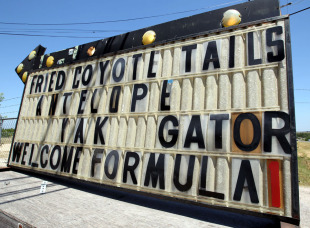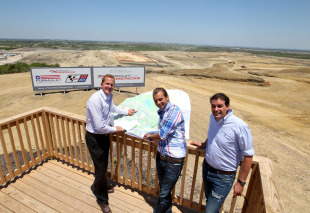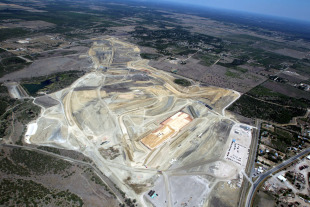Circuit gallery | www.circuitoftheamericas.com

- Circuits:
- Circuit of the Americas
- Picture Gallery:
- Circuit of the Americas construction
I travelled down to Austin following the Canadian Grand Prix and I have to say that my first impression of the new Circuit of the Americas was very positive.
After landing the night before, we arrived on site at 10:30am following a 30 minute drive from our hotel in central Austin. The main access is currently just a two-way road but the organisers are looking at turning it into a dual carriageway to cater for more traffic when the race arrives.
At the gates there was strict security so we had to flash our passes to get in to the main site where the organisers currently have air-conditioned offices. We were met by three of the guys working on the track - all with very American names - Butch, JR and Chuck. First on our itinerary was a tour in a four-wheel drive golf buggy with Butch and we immediately set off in the direction of turn one.
The first corner is at the top of a very steep hill and at the moment they have a location set up with a platform overlooking the entire site. You can probably see about 90% of the circuit from the first corner, which is amazing for a race track and they're planning to build a lot of grandstands around there to make the most of that.

From turn one the circuit goes back down the hill and into a sweeping and slightly banked right hander that then turns into what they call the Beckett turns - based on part of Silverstone's famous sector one. It's a fast left, right, left and it should be a really interesting piece of track and a challenge for the drivers. Another area of the circuit that will catch their attention is the blind brow at turn eight that feeds into turn nine and then goes back down hill to turns ten and eleven and the hairpin at the top of the circuit.
At the moment you can see the general layout and they are now preparing the base layers of the track surface. They are preparing specialist materials to lay the track on and the process is being checked every day by Tilke's employees for quality and consistency - it's very thorough. The drainage and communication systems are already in so now it's all about working on the track itself.

The sculpting of the landscape is quite remarkable and they have moved thousands of tons of earth in order to lower some areas and build others up. They're only bringing in outside material for the track and buildings, the rest of the circuit and surrounding area is being built up by simply moving earth. The majority of the spectator areas will be on huge banks beside the track and in that respect it will be a bit like Donington or Silverstone. The only difference is that the Circuit of the Americas has been specifically designed with that in mind so it should offer an even better experience for the spectators.
In terms of the pit and paddock, they are just packing out the foundation material at the moment. There's something like 300 trucks a day coming in and out - big 18-wheelers piled high with materials. There are a lot of high-skilled workers on the site, working in shifts for 12 hours of the day. If they need to up that to longer shifts they will, but at the moment they are confident they are on schedule.
In the afternoon we took a helicopter ride over the circuit to get photos of the corners as well as an overall picture of the circuit. The site is very close to the airport so our pilot had to keep in touch with air-traffic control to make sure we didn't fly too high. In the end we managed to get up to 2,300 feet, which gives you a good idea of the land surrounding the circuit from the photos. One thing that is abundantly clear is that there is plenty of room for expansion for racing schools, technology colleges, hotels and whatever else the circuit brings to the local area.

Overall, the city of Austin is a great place to visit with plenty of museums and monuments to visit. The skyline isn't as built up as some American cities, but it's an easy place to get around and has more than enough to keep the F1 circus entertained when it turns up next year. Personally, I can't wait to get back, and judging by what I saw it should be a great success.
www.suttonimages.com/ | www.gpweek.com | Mark on Twitter

